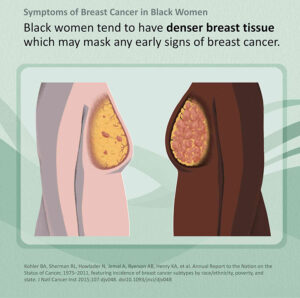 What are the signs and symptoms of breast cancer? What are the treatment options?
What are the signs and symptoms of breast cancer? What are the treatment options?
Awareness is key when it comes to keeping your breasts healthy. So, it’s important to know the facts and to learn how to recognize the signs and symptoms of breast cancer early.
Learn about common signs and symptoms, the different types of breast cancer, plus the latest treatment options.
You’ll also uncover the risk factors of breast cancer and learn the importance of regular screenings, as well as how certain diet and lifestyle choices may play a role in helping you stay healthy.
Talk with your healthcare provider (HCP) about any worries you have about breast health. By working together, you can find a way to stay on the path to wellness.
Signs of Breast Cancer
Maybe you have a family history of cancer. Perhaps you noticed a lump or swelling and you’re worried. Whatever brings you here, learn the facts about breast cancer, including common and lesser-known signs and symptoms and when it might be time to see your HCP.
Breast Cancer Risk Factors
Are obesity and alcohol consumption risk factors for breast cancer? What about age and genetics? Get answers to your questions about breast cancer, learn what may increase your risk, and find out if there’s anything you can do to lower it.
Why women may want to lay off the red meat
The next time you cook dinner, skip the juicy steak or plump hamburger and go for fresh salmon or skinless chicken breast. A large Harvard University study found that women who eat a lot of red meat had a significantly higher risk for breast cancer. But replacing a daily serving of red meat with lean protein, like chicken, fish or nuts, appeared to lower breast cancer risk.
The 2014 study, published in The BMJ, followed 89,000 women over a 20-year span of time. Participants were asked how much unprocessed red meat (beef, pork, lamb), processed red meat (bacon, sausage, hot dogs), chicken, fish and legumes (beans, lentils, peas and nuts) they ate each day. The study found that women who ate the most red meat (1.5 servings a day) had a 22 percent higher risk of breast cancer than those who had a serving a week. And each additional daily serving of red meat seemed to increase that risk another 13 percent. The study also found that cutting one serving per day of red meat and replacing it with poultry reduced the risk of breast cancer by 17 percent.
Why the link?
While the link between red meat and breast cancer isn’t clear, researchers do have a few guesses. One possibility is that red meat has been shown to release cancer-causing byproducts when cooked at high temperatures. Another theory is that hormones given to cattle to increase their growth may also raise a woman’s hormone levels. There’s also the fact that processed meats contain nitrates, which have been associated with an increased risk of breast cancer. (Or, it could be that women who eat less red meat have other healthy habits that fight breast cancer.)
The beef with red meat
Breast cancer isn’t the only issue associated with meat consumption. There is compelling evidence that meat-heavy diets raise a person’s risk for additional health problems like heart disease, Alzheimer’s disease, stroke, high cholesterol, type 2 diabetes and colorectal cancer.
Limiting your red meat intake
- Trade hamburgers for veggie burgers. Or marinate a Portobello mushroom in French dressing and throw it on the grill. Studies show that it’s just as satisfying as the real thing.
- Give up beef for beans. Your favorite soups, stews and casseroles can still taste great. Beans are an excellent meat substitute because they are high in protein, filled with fiber and low in fat.


